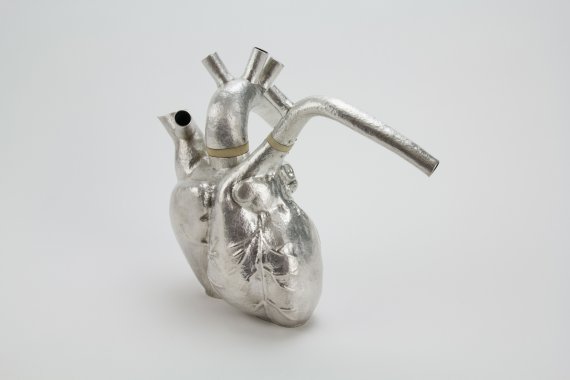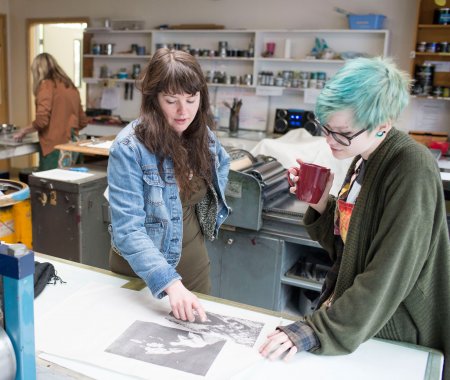Oregon College of Art and Craft to Close in May
A faculty member reflects on what is lost as the creative institution prepares for its final commencement ceremony.
May 19, 2019, will mark the last commencement of Oregon College of Art and Craft. After many years of attempted restructuring, program development, and austerity measures, its board determined that the college was no longer financially viable and decided to terminate the degree program at the end of this academic year.
The college originated as an Arts and Crafts Society, founded by Julia Hoffman in 1907. In 1979, the society (now a school), transferred to the present location in southwest Portland on land donated by Howard and Jean Vollum. The BFA program began in 1994, and graduate programs were subsequently added. Through all of its incarnations, OCAC has always privileged craft as a philosophy and a pedagogy.
One example is the OCAC Metals Department’s “rite of passage” teapot project, in which students raise functional teapots from flat sheets of metal. In fact, this year post-baccalaureate alumna Amanda Linn launched an #ocacteapot Instagram campaign to draw attention to the college’s legacy by featuring these one-of-a-kind vessels from over the years. Through deepening their understanding of the creation of utilitarian objects – how to balance design and function – the intensive studio experience at OCAC prepared students for careers as practicing studio artists.
The reasons for the closure on a macro-level have to do with fluctuating admissions, the devaluing of arts education, and a scale that was not sustainable. While the college’s small size allowed for a mentor-based education in a supportive environment, tuition could not offset expenses. Drawdowns from the small endowment covered the gaps over many years, until it was finally exhausted. The only way the college could have continued was as a philanthropic venture, not a self-sustaining entity.
Portland, for all its reputation as a hub for the creative and artisanal, has failed to support its craft institutions. Many in our community are still smarting from the closure of the Museum of Contemporary Craft in 2016. Despite a loyal core of supporters, which include past board members, donors and alumni, the college was unable to sustain robust fundraising. Although the board pursued mergers with Pacific Northwest College of Art and Portland State University, neither option worked financially while maintaining the integrity of OCAC’s craft curriculum.
Those who know OCAC and were fortunate to be part of it understand the small wooded campus on the outskirts of Portland was a unique and phenomenal educational environment. Humble to a fault, quirky, and democratic in nature, OCAC offered a place to learn and cultivate a profound creative voice. At OCAC, creativity was nurtured, challenged, strengthened, and celebrated in a manner far too rare. It was a school of practice.
Practice has many connotations: from action, to exercise, to profession. Yet the key to practice is action followed by more action, building upon iteration: redoing, remaking, researching, reflecting, returning. Practice is the activation of creativity, and creative practice is the act of using an impulse (a notion), and converting it into an outcome to seed the next search, the next act, the next impulse, the next notion.
OCAC students developed a profound understanding of their materials through this haptic practice that, in turn, became haptic knowledge. This was as true for painters as those students raising teapots. How is this to be made? What forms can the material take?
What is lost in the closing of OCAC? It was haven for generations of makers: graduate students, undergraduates, post-baccs, studio school participants, and children in the Art Adventures program. For 14 years, the college hosted Journeys in Creativity, which brought indigenous youth artists to OCAC for a residency that taught traditional skills from master makers and helped them envision new possibilities for creative studies and careers. It was the only program of its kind in the country.
A robust artist-in-residence program brought many makers to Portland, launching careers and enriching the local cultural conversation. Those intersecting communities built around a practice that honored tradition, but fostered innovation, will have to find new enclaves of craft education. But that happy, concentrated energy of many people creating together will be lost. A particular loss will be the studios and their historical and digital equipment. The proximity of the old and the new is not likely to be replicated in another institutional context. A close-knit community of faculty and staff, many of whom have spent their entire careers at OCAC, is dispersing – along with a stellar library collection with a craft focus. And Portland will lose one of only two independent art colleges – a devastating blow to its cultural economy.
Some of OCAC’s DNA will live on in the Applied Craft + Design MFA program, developed in tandem with PNCA, which will now host it. Journeys in Creativity migrated to the Longhouse Education and Culture Center at Evergreen State College in 2018. Numerous creative and business endeavors with ties to OCAC – design shops, furniture makers, galleries, residencies, and production lines – also continue to thrive in Portland and beyond and will keep a part of this legacy alive. And so it goes…
Written by Abby McGehee on behalf of the OCAC faculty.











